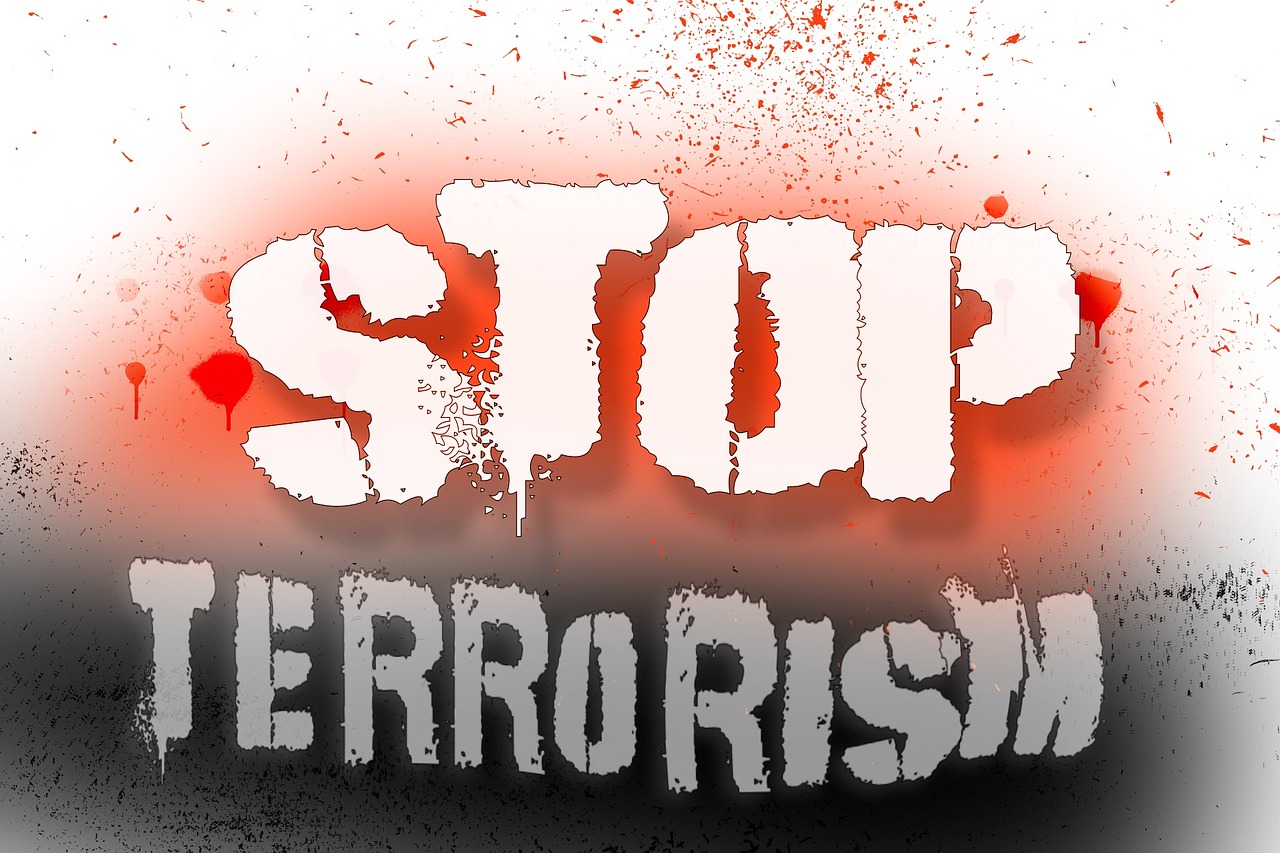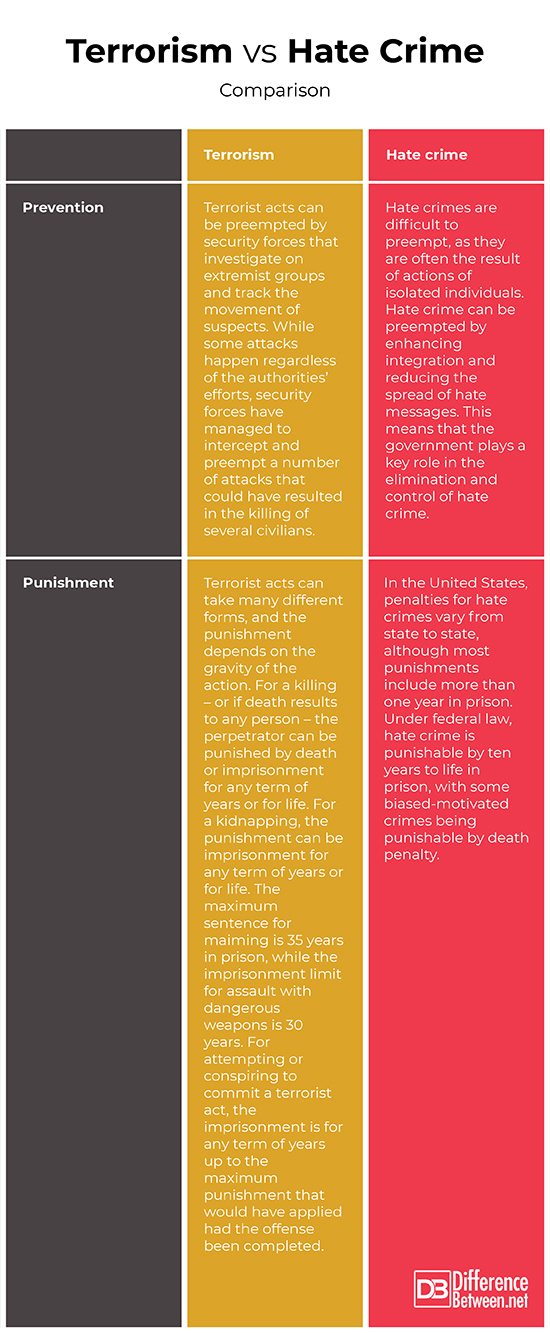Difference Between Terrorism and Hate Crime
The growing threat of racial attacks and the mounting waves of discrimination and racism that are plaguing the United States as well as large parts of Europe have translated into severe crimes and acts of violence. In many cases, when stabbings, shootings or killings occur, media agencies, as well as authorities, denounce hate crimes, and some individuals are even accused of domestic terrorism. While the two charges may sound similar, there are legal aspects that differentiate hate crime from terrorism, and that, therefore, determine the punishment. The number of hate crimes and terrorist attacks has sadly grown in recent years, and political strategies to prevent the spread of racist and sectarian sentiments have often proved ineffective.
What is Terrorism?
The definition of terrorism and domestic terrorism varies from country to country. Even within the United States, different security agencies do not agree on what is defined as terrorism nor on the number of prisoners incarcerated on terrorism charges.
In general, in the United States an act is classified as a terrorist act (namely domestic terrorism) if it is:
- Dangerous to human life and in violation of federal or state law;
- Intended to intimidate or coerce civilians or governments; and
- Occurs primarily in the United States.
In addition, the FBI defines domestic terrorism as “perpetrated by individuals and/or groups inspired by or associated with primarily US-based movements that espouse extremist ideologies of a political, religious, social, racial or environmental nature.
The US Code also provides a definition of terrorism. In fact, Title 22 defines terrorism as “premeditated, politically motivated violence perpetrated against non-combatant targets by subnational groups or clandestine agents.”
In general, when trying to determine whether a crime can be considered a terrorist act, security forces focus on the motive – which is often difficult to read.
What is Hate Crime?
Hate crime is a prejudice-motivated criminal offense which occurs when the victim is targeted because of his/her real or perceived membership in a specific social group or race. Perpetrators are often biased against one or more social groups and act in a violent or degrading way against one or more of the group’s members. Targeted groups include religion, gender identity, sex, ethnicity, language, disability, sexual orientation, nationality, and appearance.
One of the most infamous examples of hate crime is the Holocaust, which resulted in the genocide of millions of Jews – as well as other minority groups – on the basis of their ethnicity. The Holocaust was largely motivated by ethical and religious prejudice, as are most hate crimes. Victims of hate crimes are targeted because of their real or perceived membership to a group – generally, a minority group – and are terrorized or ridiculed by their attackers.
In the United States, a hate crime is considered a serious offense. In 2009, US President Barack Obama signed the Matthew Shepard and James Byrd, Jr. Hate Crimes Prevention Act, also known as the Hate Crimes Prevention Act, which expanded the existing law by including gender, disability, gender identity and sexual orientation within the categories protected by hate crime law. The act is named after two Americans who were brutally murdered because of their sexual orientation (Matthew Shepard) and their race (James Byrd, Jr.). The act also:
- Gives federal authorities greater authority and power to engage in hate crimes investigations, including those that local authorities decide not to pursue;
- Removes the prerequisite that a victim of hate crime – especially related to national origin, color, race or religion – be engaging in a federally protected activity (i.e. going to school) at the time of the attack; and
- Requires the FBI to track statistics related to hate crimes based on gender identity and gender.
In addition, most US states include hate crimes provisions in their laws, and punishment for hate crimes includes fines as well as several years in prison, depending on the nature of the offense.
Similarities Between Terrorism and Hate Crime
Despite differences in their legal definitions, terrorism and hate crime have some aspects in common. The key common feature of the two is violence, as well as the desire of the attackers to instill fear in a group of people (the victims). Other similarities between terrorism and hate crime include:
- Both crimes can be triggered and motivated by prejudices, bias and/or political or religious ideologies;
- Both can target individuals or groups of people, although terrorist acts are usually directed towards larger groups of people in order to intimidate both civilians and the government of the nation targeted;
- In both cases, perpetrators face severe punishment, including several years – or a lifetime – in prison; and
- Both terrorism and hate crimes can be triggered by prejudices or hatred against a group of people or an entire nation and can be perpetrated in name of greater ideals. Bias and prejudice are often exacerbated by media outlets and governments.
In addition, both terrorism and hate crime are on the rise, as fear of the unknown and of the “alien” is translating in a higher number of crimes and growing violence against minority groups. Poor integration policies and large waves of migration are resulting in diverse societies where different ethnical and religious groups are not always able to coexist in a peaceful manner, meaning that hate crimes against groups or individuals are becoming increasingly common.
What is the Difference Between Terrorism and Hate Crime?
Whenever acts of violence occur, especially against large groups of people and/or minority groups or individuals belonging to minority groups, authorities need to determine whether the act was a terrorist act or a hate crime. As the motive behind any attack is not always easy to understand, determining whether an act of violence is terrorism or hate crime is not an easy task for security forces. The key difference between the two lies in the motive:
- Terrorist acts are premeditated politically or religiously motivated acts of violence committed against non-combatant targets. Terrorist acts often hide extremist ideologies and are usually carried out by members or affiliated of a terrorist organization. Conversely, while hate crimes can also be the result of extremist ideologies, they are often perpetrated by individuals with bias or prejudice against minorities rather than by members of extremist groups; and
- In average, the number of terrorist attacks is much lower compared to the number of hate crimes. Terrorist attacks can often be preempted by security forces, as the key terrorist cells are known to authorities, while hate crimes are more difficult to anticipate and preempt.
Terrorism vs Hate Crime: Comparison
Building on the differences highlighted in the previous section, we can identify other aspects that differentiate terrorism and hate crime.
Summary of Terrorism vs Hate Crime
The legal definitions of terrorism and hate crime are slightly different. Terrorism is defined as premeditated, politically motivated violence perpetrated against non-combatant targets by subnational groups or clandestine agents, although different US security agencies have slightly different definitions of domestic terrorism. Conversely, hate crime is a bias-motivated criminal offense which occurs when the victim is targeted because of his/her real or perceived membership in a specific social group or race. Punishments for hate crime and terrorist acts are slightly different, although both can include death penalty or imprisonment for any term of years or for life.
- Difference Between Michelle Obama and Melania - January 29, 2019
- Difference Between Trump and Modi - December 4, 2018
- Difference Between Carbon Tax And Cap And Trade - December 4, 2018
Search DifferenceBetween.net :
Leave a Response
References :
[0]Image credit: https://pixabay.com/en/background-terrorism-black-word-1044195/
[1]Image credit: https://www.flickr.com/photos/headovmetal/4392617643
[2]Deloughery, Kathleen, Ryan D. King, and Victor Asal. "Close cousins or distant relatives? The relationship between terrorism and hate crime." Crime & Delinquency 58.5 (2012): 663-688.
[3]Perry, Barbara. In the name of hate: Understanding hate crimes. Routledge, 2002.
[4]Ronczkowski, Michael R. Terrorism and organized hate crime: Intelligence gathering, analysis and investigations. CRC press, 2017.



